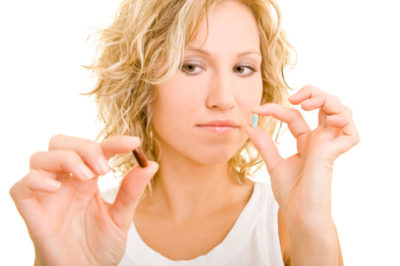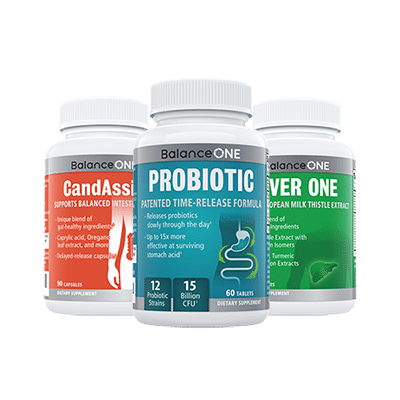Should You Take Probiotics And Antifungals Together?

There are three main elements in any good Candida treatment plan – a low-sugar diet, probiotics, and antifungals. But how can we be sure that these elements aren’t working against each other? This is a particular concern when you are taking probiotic and antifungal supplements at the same time.
Probiotics can improve your natural defences in the gut against fungal infections such as Candida albicans.
Beneficial bacteria from probiotics help keep the gut slightly acidic, which is ideal to prevent pathogens like Candida from taking hold. Candida thrives in an alkaline environment in the gut.
Another way probiotics help is by supporting the balance of good bacteria and making sure there is no space for Candida to take hold.
Antifungals are necessary to break down biofilms and destroy yeast cell walls.
Getting these two elements to work together is a crucial part of your Candida treatment.
Evidence That Probiotics And Antifungals Can Work Together
There hasn’t been a lot of research into taking probiotics and antifungals together. Most studies tend to focus on the actions of a single therapy, rather than examining the combined effect of a well-designed treatment plan. However, there has been at least one recent study that has looked at a combined probiotic/antifungal treatment, so I’ll share it with you today.
A British research team looked at using natural antifungals and probiotics together, in an effort to respond to the increasing resistance of Candida to prescription medication. They used a combination of cinnamon, garlic and Lactobacillus acidophilus (probably the most commonly used probiotic strain).
The results for one combination were encouraging – the researchers found that when garlic and the probiotic were used together, “a synergistic effect on the inhibition of candidal attachment occurred.” They concluded that “the combination of L. acidophilus and garlic should provide a preventative/treatment regime to address the growing problem with candidal infections.”
The results for cinnamon and the probiotic together were less encouraging. In fact, rather than the synergistic effect noted with the garlic, the cinnamon actually seemed to reduce the effectiveness of the probiotics. Why was this? Well, cinnamon is actually quite a strong antibiotic, and so it was killing the ‘good bacteria’ before they could do their job.
There are two different lessons to take from this study. Firstly, the effectiveness of the garlic and acidophilus combination show that probiotics and antifungals can complement each other very well indeed. Secondly, the failure of the cinnamon and acidophilus combination tells us that we need to be careful about how and when we take these supplements.
Take Your Probiotics And Antifungals At Different Times
Although the evidence suggests that probiotics can often be taken at the very same time as antifungals, you should still exercise caution. Many natural antifungals are also mild antibiotics (like cinnamon in the example above), so taking them together may dilute the effectiveness of your probiotic.
The answer is to take your probiotics and antifungals some time apart from each other. I usually recommend waiting at least an hour in between. If you do this there is very little chance of the two treatments interacting with each other. By taking them separately, you will get the most effect (and the best value) out of them both. Similarly, if you ever have to take antibiotics then you should take probiotics at least an hour apart from them too.
Our Ultimate Candida Diet program contains a straightforward timetable that you can follow to beat your Candida, as well as lots of tips on how to get the most out of your probiotics and antifungals. Choosing effective supplements can be difficult, especially with so many choices out there, so we have included as much information as possible on what you should be looking for.

3-Month Candida Elimination Kit Start Your 3-month Candida Cleanse
This Candida Kit contains all the supplements recommended on the Candida Diet:
- LIVER ONE to process and remove the toxins created by Candida.
- CANDASSIST to inhibit and weaken the Candida colonies in your gut.
- PROBIOTIC to replace the Candida yeast with probiotic bacteria.
Plus... the CANDIDA DIET RECIPE BOOK with 50+ low-sugar recipes

Can we get this same info with prebiotics in the mix. Can prebiotics be mixed with probiotics or antifungals safely without reducing effectiveness?
Hi Gregory. Prebiotics can be taken at any time, but I would recommend taking them along with your probiotics.
We have been using a product that is a combination of Grapefruit Seed Extract, Oregano, Pau D’Arco and L acidophilus. It also Vitamin C and E, some Calcium, Magnesium, and Zinc. (Solaray). What do you think about that supplement? My son (age 9) acquired a serious candida infection and we are going gluten free, sugar free and dairy free (except for yogurt). He is taking this supplement and it seems to be helping him. I Have Your Book! Thanks!
I have added cinnamon with stevia to my plain yogurt each morning. Maybe I should leave out the cinnamon.
Valerie In Katy
Hi Valerie. Products that offer a combination of antifungals and probiotics tend to be very weak. Usually you will get better results from buying separate probiotic and antifungal supplements. Check the ingredients and see how many CFUs of probiotic bacteria your supplement contains – it will probably be only 1-2bn at most. Compare this to a good probiotic supplement that might contain 30bn or more.
Hi Lisa! I just began a treatment for candida yesterday with two products that my nutritionist/chiropractor recommended–Caprylic acid by Pure Encapsulations (2xdaily)and CandiBactin-BR (2xday). I’ve also been eating gluten and dairy free for over four months now (also tested positive for soy, corn, potato, and tapioca) and been diagnosed as having a ‘leaky gut’. I began my candida tabs yesterday and within hours began sneezing–and feel as though I have full-blown spring allergies. Is this part of the die-off? How do I know if this is normal, or when to stop treatment? Thank you!!
Hi Linda
If you’re only taking one antifungal (the caprylic acid), without probiotics and without any sudden changes to your diet, it’s probably unlikely that what you’re experiencing is Candida Die-Off. That’s OK though! The whole point of a good treatment program is to avoid Die-Off and instead plan a more gradual path to recovery. Severe die-off symptoms are definitely not an aid to beating Candida.
Lisa
I definately disagree because I’ve taken caprylic acid and it is so powerful you do get a die off. It’s fairly dramatic but totally worth it!
agree with Kirra 👍
Hi Linda,
How were you diagnosed with a leaky gut. I would like to see a doc for that. They keep saying there is no test. How did you find out i will request this be done.
Hi, what dose of probiotics would you recommend to get back on track (up to how many billion/day)? Thanks
Hi Jenny
20-30 billion is a good number to start with, and then you can double your dose after some time if you are not experiencing die-off.
Lisa
We purchased a front loading washing machine five and a half years ago. A black mold quickly began developing on the machine, and there are now several class action lawsuits against the makers of the machines. Three years ago I developed digestive problems despite the fact that I ate very healthy food, and now I’m not making an enzyme required to digest my food. I’m going to start the diet and see if it helps. Has anyone else noticed a connection between these washing machines and their health?
Hi” Lisa
I am taking A bio cleanse and a pro bio5 , in the am and pm now. I was p taking two bio cleanse and two pro bio5 am and pm for 7 days.The last two days of my 7 day deal i began to feel very nauseaus and weak sore muscles and sweats, dizziness. So thats why i went to one of each am and pm. Im a insulin dependent diabetic. Is this safe for me? I did a self test and realized i had candida. The weight loss is evident since i started it 8 days ago. Thank you for taking the time to answer my question. God Bless
Hi,
I read in the web that oregano oil can kill the “good bacteria”, the flora on the gut, i’m taking syntol, candisol, candida support, candidate, magnesium and oregano oil. That’s true? Oregano oil may kill the probiotics I’m taking? Im following your diet, I eat 10g of sugar tops daily, but the sugar its from brocoli, complex carbs and things like that.
Thanks for your help.
Oregano oil is a strong antimicrobial and it can certainly kill bacteria too. In fact it is often used for treating SIBO. If you have a bacterial or fungal overgrowth, oregano oil is useful for reducing their numbers. Then you take probiotics to repopulate with ‘good bacteria’. Just don’t take the oregano oil and probiotics at the same time of day, and they won’t conflict with each other.
Hi I had a question also I am also taking oregano oil and a probiotic is it safe to take up oregano oil at night time and then the next morning a probiotic
Yes, that’s ok 🙂
Yes, I understand it’s best to be safe and separate the antifungals and probiotics by at least 1hr…but does it matter which one I should be taking first to start my day with?
thx
No it doesn’t really matter which is first.
Would there be a benefit to combining a coffee enema with garlic water as a treatment for candida? I usually combine the cooled coffee with room temperature garlic water and do the enema that way. Am I helping or hurting?
Hi,
Apart from garlic, which antifungals would you recommend?
Thanks
I read cinnamon kills everything including acidophilus dominant intestines , it’s a good sibo protocol . I read garlic kills mainly bad bacteria and helps the good guys. I haven’t tried the cinnamon protocol myself. Raw garlic seems to regulate my digestion nicel tho, 2cloves in my vitamix blender daily. Kyolic pills irritate me for some strange reason. I’m thinking maybe it’s too readily available and isn’t dispersed gradually?Raw garlic been somewhat fiberous/thick would breakdown slower maybe.
Remove the center part of the garlic (the green part) wich can cause stomach disconfort
Hi Lisa,
What is a good probiotic with the 30billions you recommend? I can only seem to find ones with 2 billion…
Thanks,
If you’re looking for a brand with 30 billion CFUs, Healthy Origins is a good choice – http://amzn.to/1pt7zjJ
I was told to use Grapefruit Seed Extract and a probiotic with meals daily for 3 months to kill fungus in the body and it would also take off skin tags or skin lesions related to yeast. I was trying to find out where this idea came from and if it was true. Sounds like sometimes these should not be done together. Also some probiotics are taken on empty stomach, is that correct?
Hi Claudia, GSE and probiotics should be taken at least an hour apart. This is because GSE is a strong antibiotic and it will kill some of the probiotic bacteria. As for probiotics, you should take them just before, or during your meal. Research has shown that this results in the best survivability for the bacteria!